-
PCM270xC Stereo Audio DAC With USB Interface, Single-Ended Headphone Output and S/PDIF Output
- 1 Features
- 2 Applications
- 3 Description
- 4 Revision History
- 5 Device Comparison Table
- 6 Pin Configuration and Functions
-
7 Specifications
- 7.1 Absolute Maximum Ratings
- 7.2 ESD Ratings
- 7.3 Recommended Operating Conditions
- 7.4 Thermal Information: PCM2704C, PCM2705C
- 7.5 Thermal Information: PCM2706C, PCM2707C
- 7.6 Electrical Characteristics: PCM2704CDB, PCM2705CDB, PCM2706CPJT, PCM2707CPJT
- 7.7 Audio Interface Timing Characteristics
- 7.8 Audio Clock Timing Characteristics
- 7.9 External ROM Read Interface Timing Characteristics
- 7.10 SPI Timing Characteristics
- 7.11 Typical Characteristics
- 8 Parameter Measurement Information
-
9 Detailed Description
- 9.1 Overview
- 9.2 Functional Block Diagrams
- 9.3
Feature Description
- 9.3.1 Clock and Reset
- 9.3.2 Operation Mode Selection
- 9.3.3 DAC
- 9.3.4 Digital Audio Interface: S/PDIF Output
- 9.3.5 Digital Audio Interface: I2S Interface Output (PCM2706C/7C)
- 9.3.6 Descriptor Data Modification
- 9.3.7 External ROM Descriptor (PCM2704C/6C)
- 9.3.8 External ROM Example
- 9.3.9 Serial Programming Interface (PCM2705C/7C)
- 9.3.10 USB Host Interface Sequence
- 9.3.11 Operating Environment
- 9.4 Device Functional Modes
- 9.5 Programming
- 9.6 Register Maps
- 10Application and Implementation
- 11Power Supply Recommendations
- 12Layout
- 13Device and Documentation Support
- 14Mechanical, Packaging, and Orderable Information
- IMPORTANT NOTICE
Package Options
Mechanical Data (Package|Pins)
- DB|28
Thermal pad, mechanical data (Package|Pins)
Orderable Information
DATA SHEET
PCM270xC Stereo Audio DAC With USB Interface, Single-Ended Headphone Output and S/PDIF Output
1 Features
- On-Chip USB Interface:
- Sampling Rates: 32 kHz, 44.1 kHz, and 48 kHz
- On-Chip Clock Generator With Single 12-MHz Clock Source
- Single Power Supply:
- Bus-Powered: 5 V, Typical (VBUS)
- Self-Powered: 3.3 V, Typical
- 16-Bit Delta-Sigma Stereo DAC
- Analog Performance at 5 V (Bus-Powered),
3.3 V (Self-Powered):- THD + N: 0.006% RL > 10 kΩ, Self-Powered
- THD + N: 0.025% RL = 32 Ω
- SNR = 98 dB
- Dynamic Range: 98 dB
- PO = 12 mW, RL = 32 Ω
- Oversampling Digital Filter
- Passband Ripple = ±0.04 dB
- Stop-Band Attenuation = –50 dB
- Single-Ended Voltage Output
- Analog LPF Included
- Analog Performance at 5 V (Bus-Powered),
- Multiple Functions:
- Up to Eight Human Interface Device (HID) Interfaces (Model and Setting Dependent)
- Suspend Flag
- S/PDIF Out With SCMS
- External ROM Interface (PCM2704C/6C)
- Serial Programming Interface (PCM2705C/7C)
- I2S Interface (Selectable on PCM2706C/7C)
2 Applications
- USB Headphones
- USB Audio Speaker
- USB CRT/LCD Monitor
- USB Audio Interface Box
- USB-Featured Consumer Audio Product
3 Description
The PCM270xC are TI's single-chip USB stereo audio digital-to-analog converters (DACs) with USB 2.0 compliant full-speed protocol controller and S/PDIF. The USB-protocol controller works with no software code, but USB descriptors can be modified in some areas (for example, vendor ID/product ID) through the use of an external ROM (PCM2704C and PCM2706C) or serial peripheral interface (SPI) (PCM2705C and PCM2707C). The PCM270xC also employ SpAct™ architecture, TI's unique system that recovers the audio clock from USB packet data. On-chip analog phase-locked loops (PLLs) with SpAct enable playback with low clock jitter.
Device Information(1)
| PART NUMBER | PACKAGE | BODY SIZE (NOM) |
|---|---|---|
| PCM2704C | SSOP (28) | 5.30 mm × 10.20 mm |
| PCM2705C | ||
| PCM2706C | TQFP (32) | 7.00 mm × 7.00 mm |
| PCM2707C |
- For all available packages, see the orderable addendum at the end of the data sheet.
Block Diagram
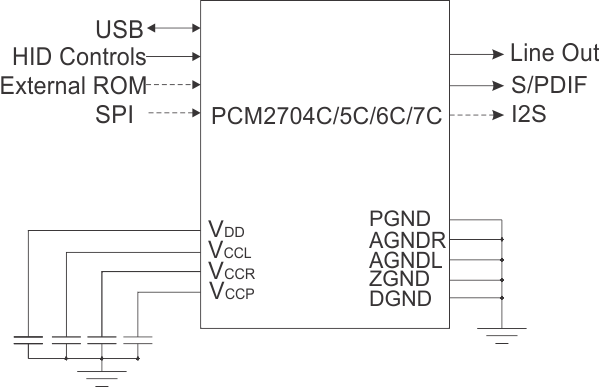
4 Revision History
Changes from A Revision (July 2012) to B Revision
- Added Handling Ratings table, Feature Description section, Device Functional Modes, Application and Implementation section, Power Supply Recommendations section, Layout section, Device and Documentation Support section, and Mechanical, Packaging, and Orderable Information section Go
Changes from * Revision (August 2011) to A Revision
5 Device Comparison Table
| FEATURE | PCM2704C | PCM2705C | PCM2706C | PCM2707C |
|---|---|---|---|---|
| Supply Voltage (V) | 3.3, 5 | 3.3, 5 | 3.3, 5 | 3.3, 5 |
| Control Interface | HID | HID, SPI | HID, SPI | HID, SPI |
| Additional Features | S/PDIF Output HP Output Ext. ROM I/F |
S/PDIF Output HP Output |
S/PDIF Output HP Output Ext. ROM I/F |
S/PDIF Output HP Output |
| Package Group | SSOP | SSOP | TQFP | TQFP |
6 Pin Configuration and Functions
PCM2704C, PCM2705C DB Package
28-Pin SSOP
Top View

Pin Functions: DB Package (PCM2704C/PCM2705C)
| PIN | I/O | DESCRIPTION | |
|---|---|---|---|
| NAME | NO. | ||
| AGNDL | 12 | — | Analog ground for headphone amplifier of L-channel |
| AGNDR | 17 | — | Analog ground for headphone amplifier of R-channel |
| CK | 2 | O | Clock output for external ROM (PCM2704C). Must be left open (PCM2705C). |
| D+ | 9 | I/O | USB differential input/output plus(1) |
| D– | 8 | I/O | USB differential input/output minus(1) |
| DGND | 6 | — | Digital ground |
| DOUT | 5 | O | S/PDIF output |
| DT | 3 | I/O | Data input/output for external ROM (PCM2704C). Must be left open with pullup resistor (PCM2705C).(1) |
| HID0/MS | 22 | I | HID key state input (mute), active high (PCM2704C). MS input (PCM2705C)(3) |
| HID1/MC | 23 | I | HID key state input (volume up), active high (PCM2704C). MC input (PCM2705C)(3) |
| HID2/MD | 24 | I | HID key state input (volume down), active high (PCM2704C). MD input (PCM2705C)(3) |
| HOST | 21 | I | Host detection during self-powered operation (connect to VBUS). Max power select during bus-powered operation (low: 100 mA, high: 500 mA).(2) |
| PGND | 19 | — | Analog ground for DAC, OSC, and PLL |
| PSEL | 4 | I | Power source select (low: self-power, high: bus-power)(1) |
| SSPND | 27 | O | Suspend flag, active low (low: suspend, high: operational) |
| TEST0 | 26 | I | Test pin. Must be set high(1) |
| TEST1 | 25 | I | Test pin. Must be set high(1) |
| VBUS | 10 | — | Connect to USB power (VBUS) for bus-powered operation. Connect to VDD for self-powered operation. |
| VCCL | 13 | — | Analog power supply for headphone amplifier of L-channel(4) |
| VCCP | 20 | — | Analog power supply for DAC, OSC, and PLL(4) |
| VCCR | 16 | — | Analog power supply for headphone amplifier of R-channel(4) |
| VCOM | 18 | — | Common voltage for DAC (VCCP/2). Connect decoupling capacitor to PGND. |
| VDD | 7 | — | Digital power supply(4) |
| VOUTL | 14 | O | DAC analog output for L-channel |
| VOUTR | 15 | O | DAC analog output for R-channel |
| XTI | 28 | I | Crystal oscillator input(1) |
| XTO | 1 | O | Crystal oscillator output |
| ZGND | 11 | — | Ground for internal regulator |
(1) LV-TTL level.
(2) LV-TTL level, 5-V tolerant
(3) LV-TTL level with internal pulldown
(4) Connect decoupling capacitor to GND. Supply 3.3 V for self-powered applications.
PCM2706C, PCM2707C PJT Package
32-Pin TQFP
Top View

Pin Functions: PJT Package (PCM2706C/PCM2707C)
| PIN | I/O | DESCRIPTION | |
|---|---|---|---|
| NAME | NO. | ||
| AGNDL | 26 | — | Analog ground for headphone amplifier of L-channel |
| AGNDR | 31 | — | Analog ground for headphone amplifier of R-channel |
| CK | 14 | O | Clock output for external ROM (PCM2706C). Must be left open (PCM2707C). |
| D+ | 23 | I/O | USB differential input/output plus(1) |
| D– | 22 | I/O | USB differential input/output minus(1) |
| DGND | 20 | — | Digital ground |
| DOUT | 17 | O | S/PDIF output/I2S data output |
| DT | 15 | I/O | Data input/output for external ROM (PCM2706C). Must be left open with pullup resistor (PCM2707C).(1) |
| FSEL | 9 | I | Function select (low: I2S data output, high: S/PDIF output)(1) |
| FUNC0 | 5 | I/O | HID key state input (next track), active high (FSEL = 1). I2S LR clock output (FSEL = 0).(3) |
| FUNC1 | 19 | I/O | HID key state input (previous track), active high (FSEL = 1). I2S bit clock output (FSEL = 0).(3) |
| FUNC2 | 18 | I/O | HID key state input (stop), active high (FSEL = 1). I2S system clock output (FSEL = 0).(3) |
| FUNC3 | 4 | I | HID key state input (play/pause), active high (FSEL = 1). I2S data input (FSEL = 0).(3) |
| HID0/MS | 6 | I | HID key state input (mute), active high (PCM2706C). MS input (PCM2707C).(3) |
| HID1/MC | 7 | I | HID key state input (volume up), active high (PCM2706C). MC input (PCM2707C).(3) |
| HID2/MD | 8 | I | HID key state input (volume down), active high (PCM2706C). MD input (PCM2707C).(3) |
| HOST | 3 | I | Host detection during self-powered operation (connect to VBUS). Max power select during bus-powered operation. (low: 100 mA, high: 500 mA).(2) |
| PGND | 1 | — | Analog ground for DAC, OSC, and PLL |
| PSEL | 16 | I | Power source select (low: self-power, high: bus-power)(1) |
| SSPND | 11 | O | Suspend flag, active low (low: suspend, high: operational) |
| TEST | 10 | I | Test pin. Must be set high(1) |
| VBUS | 24 | — | Connect to USB power (VBUS) for bus-powered operation. Connect to VDD for self-powered operation. |
| VCCL | 27 | — | Analog power supply for headphone amplifier of L-channel(4) |
| VCCP | 2 | — | Analog power supply for DAC, OSC, and PLL(4) |
| VCCR | 30 | — | Analog power supply for headphone amplifier of R-channel(4) |
| VCOM | 32 | — | Common voltage for DAC (VCCP/2). Connect decoupling capacitor to PGND. |
| VDD | 21 | — | Digital power supply(4) |
| VOUTL | 28 | O | DAC analog output for L-channel |
| VOUTR | 29 | O | DAC analog output for R-channel |
| XTI | 12 | I | Crystal oscillator input(1) |
| XTO | 13 | O | Crystal oscillator output |
| ZGND | 25 | — | Ground for internal regulator |
(1) LV-TTL level
(2) LV-TTL level, 5-V tolerant
(3) LV-TTL level with internal pulldown
(4) Connect decoupling capacitor to GND. Supply 3.3 V for self-powered applications.
7 Specifications
7.1 Absolute Maximum Ratings
Over operating free-air temperature range unless otherwise noted. (1)| MIN | MAX | UNIT | ||
|---|---|---|---|---|
| Supply voltage | VBUS | –0.3 | 6.5 | V |
| VCCP, VCCL, VCCR, VDD | –0.3 | 4 | V | |
| Supply voltage differences | VCCP, VCCL, VCCR, VDD | ±0.1 | V | |
| Ground voltage differences | PGND, AGNDL, AGNDR, DGND, ZGND | ±0.1 | V | |
| Digital input voltage | HOST | –0.3 | 6.5 | V |
| D+, D–, HID0/MS, HID1/MC, HID2/MD, XTI, XTO, DOUT, SSPND, CK, DT, PSEL, FSEL, TEST, TEST0, TEST1, FUNC0, FUNC1, FUNC2, FUNC3 | –0.3 | (VDD + 0.3) < 4 | V | |
| Analog input voltage | VCOM | –0.3 | (VCCP + 0.3) < 4 | V |
| VOUTR | –0.3 | (VCCR + 0.3) < 4 | V | |
| VOUTL | –0.3 | (VCCL + 0.3) < 4 | V | |
| Input current (any pins except supplies) | ±10 | mA | ||
| Ambient temperature under bias | –40 | 125 | °C | |
| Junction temperature | 150 | °C | ||
| Package temperature (IR reflow, peak) | 260 | °C | ||
| Storage temperature, Tstg | –55 | 150 | °C | |
(1) Stresses beyond those listed under Absolute Maximum Ratings may cause permanent damage to the device. These are stress ratings only, and functional operation of the device at these or any other conditions beyond those indicated under Recommended Operating Conditions is not implied. Exposure to absolute-maximum-rated conditions for extended periods may affect device reliability.
7.2 ESD Ratings
| MAX | UNIT | |||
|---|---|---|---|---|
| V(ESD) | Electrostatic discharge | Human body model (HBM), per ANSI/ESDA/JEDEC JS-001, all pins(1) | ±3000 | V |
| Charged device model (CDM), per JEDEC specification JESD22-C101, all pins(2) | ±1500 | |||
(1) JEDEC document JEP155 states that 500-V HBM allows safe manufacturing with a standard ESD control process.
(2) JEDEC document JEP157 states that 250-V CDM allows safe manufacturing with a standard ESD control process.
7.3 Recommended Operating Conditions
Over operating free-air temperature range.| MIN | NOM | MAX | UNIT | ||
|---|---|---|---|---|---|
| Supply voltage | VBUS | 4.35 | 5 | 5.25 | V |
| VCCP, VCCL, VCCR, VDD | 3 | 3.3 | 3.6 | ||
| Digital input logic level | TTL-compatible | ||||
| Digital input clock frequency | 11.994 | 12 | 12.006 | MHz | |
| Analog output load resistance | 16 | 32 | Ω | ||
| Analog output load capacitance | 100 | pF | |||
| Digital output load capacitance | 20 | pF | |||
| Operating free-air temperature, TA | –25 | 85 | °C | ||
7.4 Thermal Information: PCM2704C, PCM2705C
| THERMAL METRIC(1) | PCM2704C, PCM2705C | UNIT | |
|---|---|---|---|
| DB (SSOP) | |||
| 28 PINS | |||
| RθJA | Junction-to-ambient thermal resistance | 68.2 | °C/W |
| RθJC(top) | Junction-to-case (top) thermal resistance | 27.2 | °C/W |
| RθJB | Junction-to-board thermal resistance | 29.5 | °C/W |
| ψJT | Junction-to-top characterization parameter | 2.7 | °C/W |
| ψJB | Junction-to-board characterization parameter | 29.1 | °C/W |
(1) For more information about traditional and new thermal metrics, see the Semiconductor and IC Package Thermal Metrics application report, SPRA953.
7.5 Thermal Information: PCM2706C, PCM2707C
| THERMAL METRIC(1) | PCM2706C, PCM2707C | UNIT | |
|---|---|---|---|
| PJT (TQFP) | |||
| 32 PINS | |||
| RθJA | Junction-to-ambient thermal resistance | 68.2 | °C/W |
| RθJC(top) | Junction-to-case (top) thermal resistance | 27.2 | °C/W |
| RθJB | Junction-to-board thermal resistance | 29.5 | °C/W |
| ψJT | Junction-to-top characterization parameter | 2.7 | °C/W |
| ψJB | Junction-to-board characterization parameter | 29.1 | °C/W |
(1) For more information about traditional and new thermal metrics, see the Semiconductor and IC Package Thermal Metrics application report, SPRA953.
7.6 Electrical Characteristics: PCM2704CDB, PCM2705CDB, PCM2706CPJT, PCM2707CPJT
All specifications at TA = 25°C, VBUS = 5 V, ƒS = 44.1 kHz, ƒIN = 1 kHz, and 16-bit data (unless otherwise noted). For the Host interface, apply USB revision 1.1, full-speed. For audio data format, use USB isochronous data format.| PARAMETER | TEST CONDITIONS | MIN | TYP | MAX | UNIT | ||
|---|---|---|---|---|---|---|---|
| INPUT LOGIC | |||||||
| VIH | Input logic high level | 2 | 3.3 | VDC | |||
| Input logic high level(1) | 2 | 5.5 | |||||
| VIL | Input logic low level | –0.3 | 0.8 | VDC | |||
| Input logic low level(1) | –0.3 | 0.8 | |||||
| IIH | Input logic high current(2) | VIN = 3.3 V | ±10 | μA | |||
| Input logic high current | VIN = 3.3 V | 65 | 100 | ||||
| IIL | Input logic low current(2) | VIN = 0 V | ±10 | μA | |||
| Input logic low current | VIN = 0 V | ±10 | |||||
| OUTPUT LOGIC | |||||||
| VOH | Output logic high level(3) | IOH = –2 mA | 2.8 | VDC | |||
| Output logic high level | IOH = –2 mA | 2.4 | |||||
| VOL | Output logic low level(3) | IOL = 2 mA | 0.3 | VDC | |||
| Output logic low level | IOL = 2 mA | 0.4 | |||||
| CLOCK FREQUENCY | |||||||
| Input clock frequency, XTI | 11.994 | 12 | 12.006 | MHz | |||
| ƒS | Sampling frequency | 32 44.1 48 |
kHz | ||||
| DAC CHARACTERISTICS | |||||||
| Resolution | 16 | bits | |||||
| Audio data channel | 1, 2 | channel | |||||
| DC ACCURACY | |||||||
| Gain mismatch, channel-to-channel | ±2 | ±8 | % of FSR | ||||
| Gain error | ±2 | ±8 | % of FSR | ||||
| Bipolar zero error | ±3 | ±6 | % of FSR | ||||
| DYNAMIC PERFORMANCE (4) | |||||||
| THD + N | Total harmonic distortion + noise | Line (5) | RL > 10 kΩ, self-powered, VOUT = 0 dB | 0.006% | 0.01% | ||
| RL > 10 kΩ, bus-powered, VOUT = 0 dB | 0.012% | 0.02% | |||||
| Headphone | RL = 32 Ω, self- or bus-powered, VOUT = 0 dB | 0.025% | |||||
| THD + N | Total harmonic distortion + noise | VOUT = –60 dB | 2% | ||||
| Dynamic range | EIAJ, A-weighted | 90 | 98 | dB | |||
| SNR | Signal-to-noise ratio | EIAJ, A-weighted | 90 | 98 | dB | ||
| Channel separation | 60 | 70 | dB | ||||
| ANALOG OUTPUT | |||||||
| Output voltage | 0.55 VCCL
0.55 VCCR |
VPP | |||||
| Center voltage | 0.5 VCCP | V | |||||
| Load impedance | Line | AC-coupling | 10 | kΩ | |||
| Headphone | AC-coupling | 16 | 32 | Ω | |||
| LPF frequency response | –3 dB | 140 | kHz | ||||
| ƒ = 20 kHz | –0.1 | dB | |||||
| DIGITAL FILTER PERFORMANCE | |||||||
| Passband | 0.454 ƒS | Hz | |||||
| Stop band | 0.546 ƒS | Hz | |||||
| Passband ripple | ±0.04 | dB | |||||
| Stop band attenuation | –50 | dB | |||||
| Delay time | 20 / ƒS | s | |||||
| POWER SUPPLY REQUIREMENTS | |||||||
| Voltage range | VBUS | Bus-powered | 4.35 | 5 | 5.25 | VDC | |
| VCCP, VCCL, VCCR, VDD | Self-powered | 3 | 3.3 | 3.6 | |||
| Supply current | Line | DAC operation | 23 | 30 | mA | ||
| Headphone | DAC operation (RL = 32 Ω) | 35 | 46 | ||||
| Line/headphone | Suspend mode (6) | 150 | 190 | μA | |||
| Power dissipation (self-powered) | Line | DAC operation | 76 | 108 | mW | ||
| Headphone | DAC operation (RL = 32 Ω) | 116 | 166 | ||||
| Line/headphone | Suspend mode (6) | 495 | 684 | μW | |||
| Power dissipation (bus-powered) | Line | DAC operation | 115 | 158 | mW | ||
| Headphone | DAC operation (RL = 32 Ω) | 175 | 242 | ||||
| Line/headphone | Suspend mode (6) | 750 | 998 | μW | |||
| Internal power-supply voltage (7) | VCCP, VCCL, VCCR, VDD | Bus-powered | 3.2 | 3.35 | 3.5 | VDC | |
| TEMPERATURE RANGE | |||||||
| Operating temperature | –25 | 85 | °C | ||||
(1) HOST pin.
(2) D+, D–, HOST, TEST, TEST0, TEST1, DT, PSEL, FSEL, XTI pins.
(3) FUNC0, FUNC1, and FUNC2 pins.
(4) ƒIN = 1 kHz, using the System Two Cascade™ audio measurement system by Audio Precision® in RMS mode with a 20-kHz low-pass filter (LPF) and 400-Hz high-pass filter (HPF).
(5) THD + N performance varies slightly, depending on the effective output load, including dummy load R7 and R8 in Figure 35.
(6) In USB suspended state
(7) VDD, VCCP, VCCL, VCCR pins. These pins work as output pins of internal power supply for bus-powered operation.
7.7 Audio Interface Timing Characteristics
Load capacitance of LRCK, BCK, and DOUT is 20 pF. For timing diagrams, see Figure 1 and Figure 2.| MIN | MAX | UNIT | ||
|---|---|---|---|---|
| t(BCY) | BCK pulse cycle time | 300 | ns | |
| t(BCH) | BCK pulse duration, high | 100 | ns | |
| t(BCL) | BCK pulse duration, low | 100 | ns | |
| t(BL) | LRCK delay time from BCK falling edge | –20 | 40 | ns |
| t(BD) | DOUT delay time from BCK falling edge | –20 | 40 | ns |
| t(LD) | DOUT delay time from LRCK edge | –20 | 40 | ns |
| t(DS) | DIN setup time | 20 | ns | |
| t(DH) | DIN hold time | 20 | ns | |
7.8 Audio Clock Timing Characteristics
Load capacitance is 20 pF. For timing diagrams, see Figure 3.| MIN | MAX | UNIT | ||
|---|---|---|---|---|
| t(SLL), t(SLH) | LRCK delay time from SYSCK rising edge | –5 | 10 | ns |
| t(SBL), t(SBH) | BCK delay time from SYSCK rising edge | –5 | 10 | ns |
7.9 External ROM Read Interface Timing Characteristics
For timing diagrams, see Figure 4.| MIN | MAX | UNIT | ||
|---|---|---|---|---|
| ƒ(CK) | CK clock frequency | 100 | kHz | |
| t(BUF) | Bus free time between a STOP and a START condition | 4.7 | μs | |
| t(LOW) | Low period of the CK clock | 4.7 | μs | |
| t(HI) | High period of the CK clock | 4 | μs | |
| t(RS-SU) | Setup time for START/repeated START condition | 4.7 | μs | |
| t(S-HD)
t(RS-HD) |
Hold time for START/repeated START condition | 4 | μs | |
| t(D-SU) | Data setup time | 250 | ns | |
| t(D-HD) | Data hold time | 0 | 900 | ns |
| t(CK-R) | Rise time of CK signal | 20 + 0.1 CB | 1000 | ns |
| t(CK-F) | Fall time of CK signal | 20 + 0.1 CB | 1000 | ns |
| t(DT-R) | Rise time of DT signal | 20 + 0.1 CB | 1000 | ns |
| t(DT-F) | Fall time of DT signal | 20 + 0.1 CB | 1000 | ns |
| t(P-SU) | Setup time for STOP condition | 4 | μs | |
| CB | Capacitive load for DT and CK lines | 400 | pF | |
| VNH | Noise margin at high level for each connected device (including hysteresis) | 0.2 VDD | V | |
7.10 SPI Timing Characteristics
For timing diagrams, see Figure 5.| MIN | MAX | UNIT | ||
|---|---|---|---|---|
| t(MCY) | MC pulse cycle time | 100 | ns | |
| t(MCL) | MC low-level time | 50 | ns | |
| t(MCH) | MC high-level time | 50 | ns | |
| t(MHH) | MS high-level time | 100 | ns | |
| t(MLS) | MS falling edge to MC rising edge | 20 | ns | |
| t(MLH) | MS hold time | 20 | ns | |
| t(MDH) | MD hold time | 15 | ns | |
| t(MDS) | MD setup time | 20 | ns | |
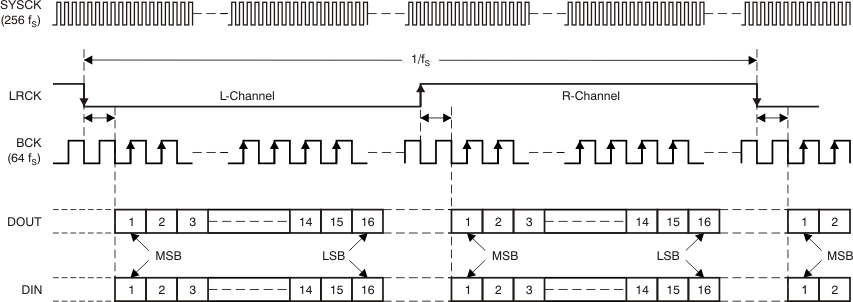 Figure 1. Audio Data Interface Format
Figure 1. Audio Data Interface Format
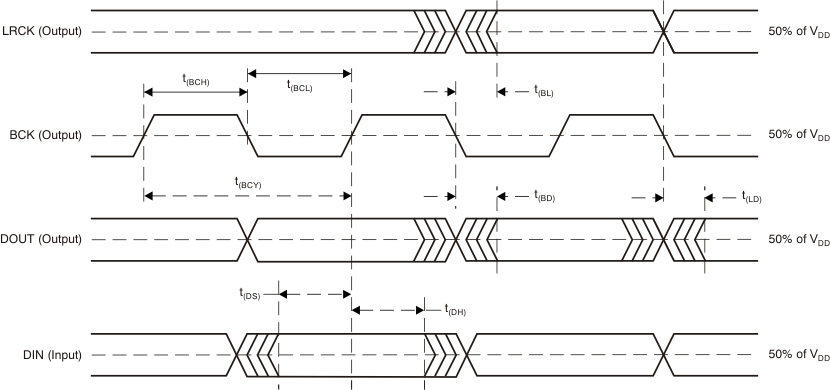 Figure 2. Audio Interface Timing
Figure 2. Audio Interface Timing
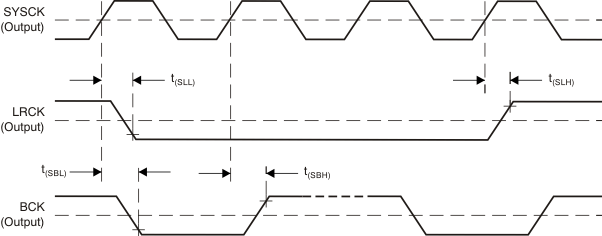 Figure 3. Audio Clock Timing
Figure 3. Audio Clock Timing
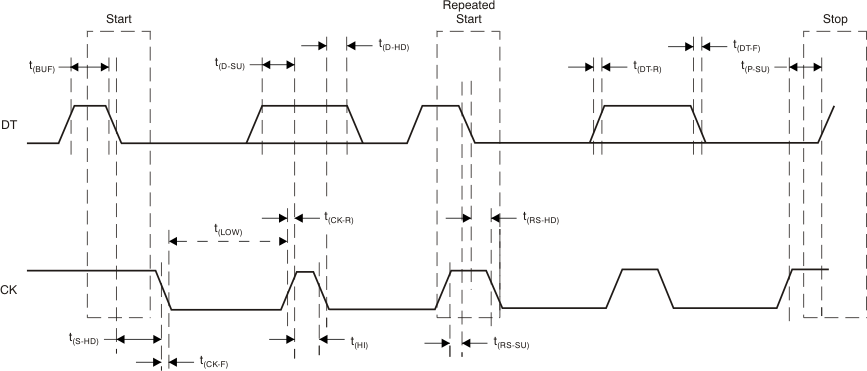 Figure 4. External ROM Read Interface Timing Requirements
Figure 4. External ROM Read Interface Timing Requirements
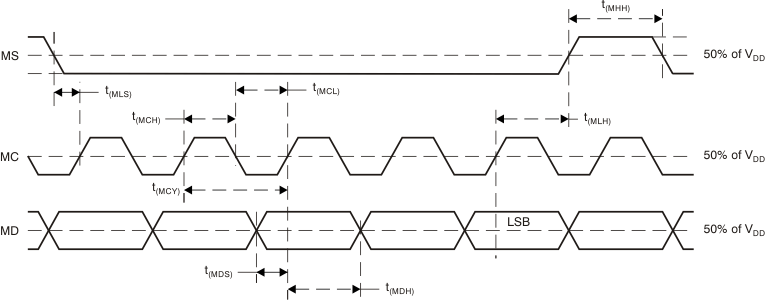 Figure 5. SPI Timing Diagram
Figure 5. SPI Timing Diagram
7.11 Typical Characteristics
7.11.1 Internal Filter: DAC Digital Interpolation Filter Frequency Response
All specifications at TA = 25°C, VBUS = 5 V, ƒS = 44.1 kHz, ƒIN = 1 kHz, 16-bit data (unless otherwise noted).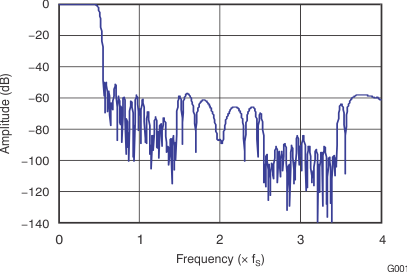 Figure 6. Frequency Response
Figure 6. Frequency Response
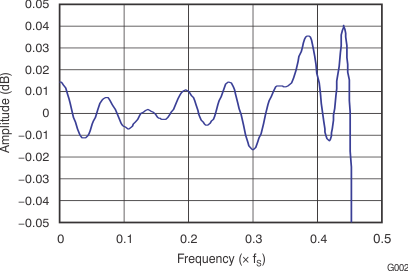 Figure 7. Passband Ripple
Figure 7. Passband Ripple
7.11.2 Internal Filter: DAC Analog Low-Pass Filter Frequency Response
All specifications at TA = 25°C, VBUS = 5 V, ƒS = 44.1 kHz, ƒIN = 1 kHz, 16-bit data (unless otherwise noted).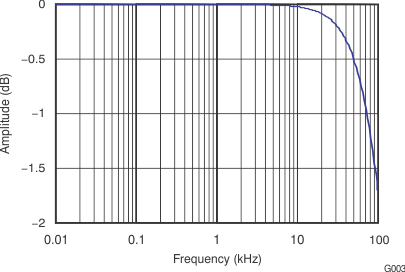 Figure 8. Passband Characteristics
Figure 8. Passband Characteristics
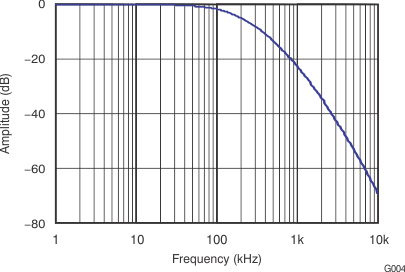 Figure 9. Stop Band Characteristics
Figure 9. Stop Band Characteristics
7.11.3 General Characteristics
All specifications at TA = 25°C, VBUS = 5 V, ƒS = 44.1 kHz, ƒIN = 1 kHz, 16-bit data (unless otherwise noted).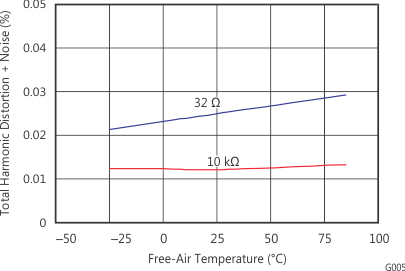 Figure 10. Total Harmonic Distortion + Noise vs Free-Air Temperature
Figure 10. Total Harmonic Distortion + Noise vs Free-Air Temperature
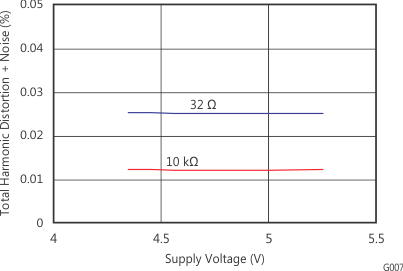 Figure 12. Total Harmonic Distortion + Noise vs Supply Voltage
Figure 12. Total Harmonic Distortion + Noise vs Supply Voltage
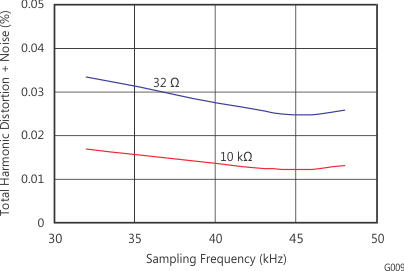 Figure 14. Total Harmonic Distortion + Noise vs Sampling Frequency
Figure 14. Total Harmonic Distortion + Noise vs Sampling Frequency
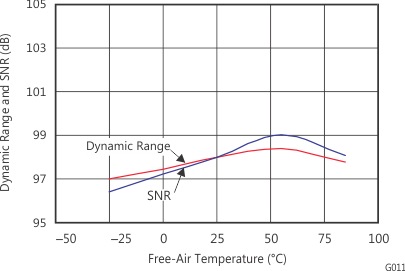 Figure 16. Dynamic Range and SNR vs Free-Air Temperature
Figure 16. Dynamic Range and SNR vs Free-Air Temperature
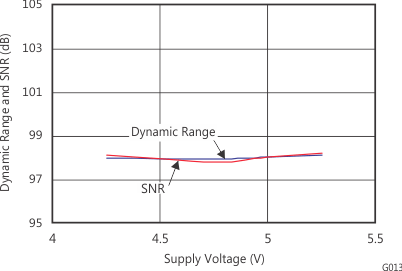 Figure 18. Dynamic Range and SNR vs Supply Voltage
Figure 18. Dynamic Range and SNR vs Supply Voltage
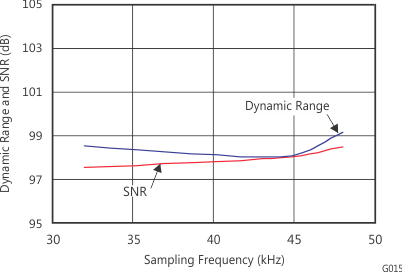 Figure 20. Dynamic Range and SNR vs Sampling Frequency
Figure 20. Dynamic Range and SNR vs Sampling Frequency
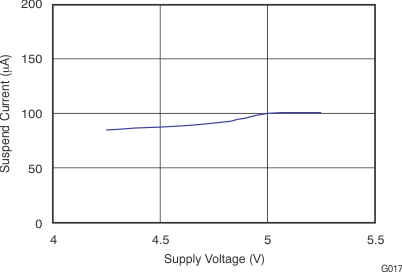 Figure 22. Suspend Current vs Supply Voltage
Figure 22. Suspend Current vs Supply Voltage
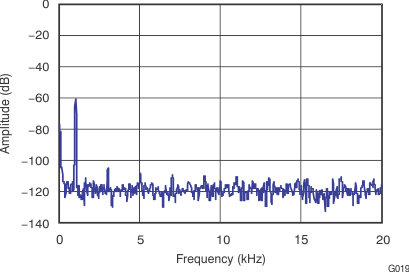 Figure 24. Output Spectrum (–60 dB, N = 8192)
Figure 24. Output Spectrum (–60 dB, N = 8192)
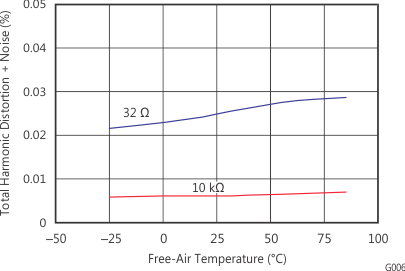 Figure 11. Total Harmonic Distortion + Noise vs Free-Air Temperature
Figure 11. Total Harmonic Distortion + Noise vs Free-Air Temperature
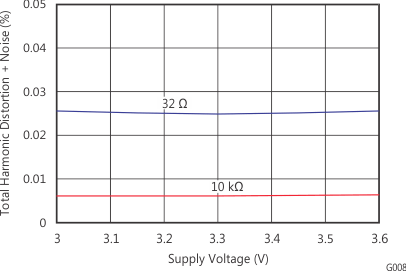 Figure 13. Total Harmonic Distortion + Noise vs Supply Voltage
Figure 13. Total Harmonic Distortion + Noise vs Supply Voltage
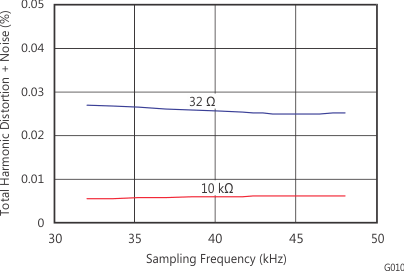 Figure 15. Total Harmonic Distortion + Noise vs Sampling Frequency
Figure 15. Total Harmonic Distortion + Noise vs Sampling Frequency
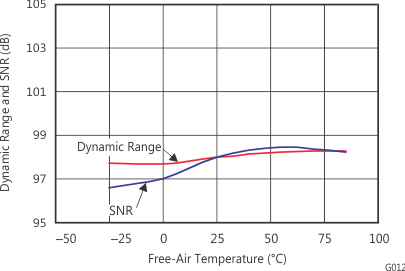 Figure 17. Dynamic Range and SNR vs Free-Air Temperature
Figure 17. Dynamic Range and SNR vs Free-Air Temperature
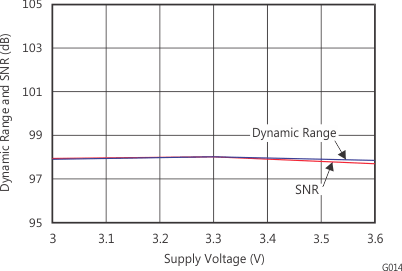 Figure 19. Dynamic Range and SNR vs Supply Voltage
Figure 19. Dynamic Range and SNR vs Supply Voltage
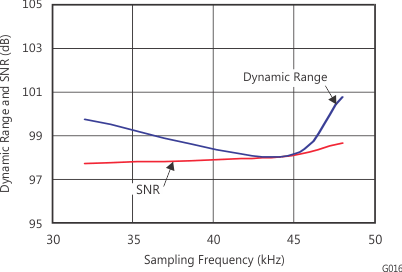 Figure 21. Dynamic Range and SNR vs Sampling Frequency
Figure 21. Dynamic Range and SNR vs Sampling Frequency
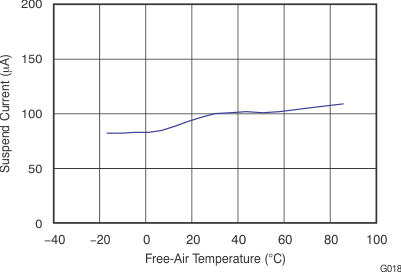 Figure 23. Suspend Current vs Free-Air Temperature
Figure 23. Suspend Current vs Free-Air Temperature
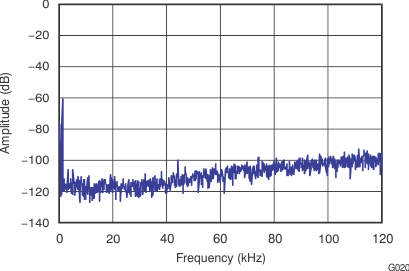 Figure 25. Output Spectrum (–60 dB, N = 8192)
Figure 25. Output Spectrum (–60 dB, N = 8192)